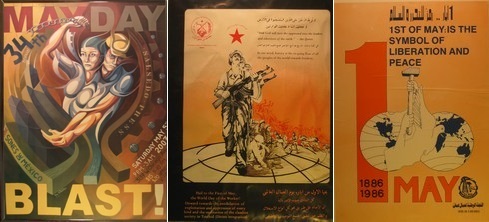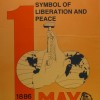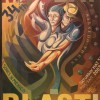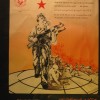Above: An art/history exhibit in area Libraries starting Tuesday focuses on posters promoting working class struggles around the world.
Stephen Lewis is bringing an exhibit of May Day posters to the Southborough Library and (plus Westborough and Northborough libraries). Fittingly, the exhibit launches on May 1st.

Throughout the month, the exhibit will be on display from a ½ hour after opening to a ½ hour before closing. (See flyer for times.)
A press release about a exhibit purports that most Americans associate May Day with tanks parading through Moscow streets.
I found that surprising since I had always associated it with maypoles and flowers. In fact, until recently, I was unaware over a hundred countries use the day to celebrate it workers. (After all, our nation designates Labor Day for that.)
But it’s appropriate that I’m learning about the holiday through the exhibit’s promotional materials. Sharing the history and context of the May Day promotional posters is a big component of the exhibit.
In fact, the press release refers to the exhibit as “part, graphic art, history, culture and political.”
Artists may appreciate the various ways a theme is depicted by many different artists, hailing from different countries and cultures. Lewis has made the foreign language posters more accessible by including information, including translation of key phrases, to English. Historians can see what social and political changes were being advocated for in different countries at different times. Activists can see some of their favorite causes, including the celebration of May Day itself, agitated for in these posters. One example of interest Lewis described is the difference between the rather tame writing in the Liechtenstein posters, where workers are generally treated well, and the much more militant language in posters from countries like El Salvador, where union activists have been killed by government forces, and labor unions severely repressed.
Posters from Lewis’ collection include ones from France, Spain, Namibia, Australia, Denmark, Austria, Bangladesh, Belgium, Brazil, Canada, Cuba, Germany and Liechtenstein. (Scroll down for a better look at a few examples). The press release reflects on an irony in the lack of celebration within our own country:
in most countries, the celebrations are not about military parades, rather about highlighting struggles workers are going through. The reason it is not celebrated in a number of other countries, is because organized workers are severely repressed. It is not a recognized holiday in the US and Canada. Instead, those two countries celebrate Labor Day. The reason for this is that the celebration of May Day was linked to Communism, Socialism, militant workers and other activists who fought for improving the lot of workers. This is not something the people in power in this country wanted to celebrate. The irony of this is that the movement of celebrating May Day as a workers’ holiday emanated from right here in the US. A national strike was called for May 1, 1886, if Congress did not pass legislation shortening the work day to 8 hours. On May 1, 60,000 workers went on strike in Chicago. The strike gained momentum and two days later the police shot several strikers. Following further violence in Chicago, the movement spread worldwide. The struggle for the 8 hour day was realized years later.
The project is supported in part by grants from the Northborough, Southborough and Westborough Cultural Councils, local agencies which are supported by the Massachusetts Cultural Council, a state agency, and by Roofers Local 33, Asbestos Workers Local 6, IBEW Local 103, and Painters DC 35.
Lewis has a collection of 7100 posters which he exhibits regularly around Massachusetts. Here are a few examples ones that will be displayed at the area libraries this month (click to enlarge):
For more information on this month’s exhibit, click here.





